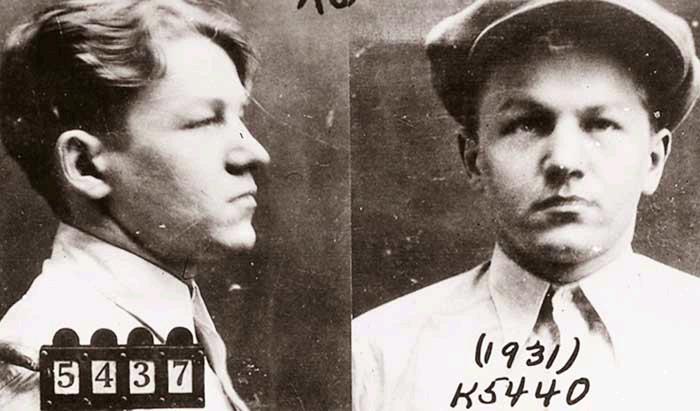长一张娃娃脸的好处
By+Zaria+Gorvett
George Nelson was Americas most wanted man—a gangster so bloodthirsty, Al Capone booted him out of his gang for being too violent.2
On 20 April 1934, the police decided to get him. Theyd been tipped off that he was staying at a lakeside hotel in Wisconsin, so they launched a secret operation to gun him down.3
But George Nelson had been blessed with a round face, large eyes and cute little nose. His fellow crooks4 called him “Babyface”—behind his back, of course. He hardly looked like a criminal5.
When the agents arrived, they locked eyes on a trio of men that apparently did.6 The men—who were actually undercover FBI agents—were gunned down in a matter of seconds, allowing Babyface and his fellow outlaws to escape.7
They jumped out of a second-floor window, followed the edge of the lake for several miles, stole a car and got away.
From literally getting away with murder, to monopolizing parental love and seducing the opposite sex, the babyface is a potent social weapon.8
The doe-eyed look can help people win over their enemies, elicit help from strangers and get ahead in their careers.9 It makes politicians seem more trustworthy, crooks less likely to be convicted and sentencing less severe.10
In all, babyfaced individuals are thought of as more honest, naive, warm, kind, approachable, trustworthy, likeable, familiar, and charismatic than the rest of us.11
This trust is misplaced. In fact, theyre more—not less—likely to become criminals. And once theyve turned their backs on the law, they tend to commit more offences than those who look the part.12
By the way—inexplicably—across diverse cultures,13 in every corner of the globe, baby-faced women are rated as the most attractive. “The big eyes, the long lashes, the arched brows, the plump lips, the small chins, the round face, the cute little nose—if I wasnt describing a baby, Id be describing a supermodel,” says Caroline Keating, an expert in non-verbal communication at Colgate University, New York.14
So whats going on?
Weve been judging people based on the way they look for thousands of years. The ancient Greeks turned it into a science, “physiognomy15”. As early as 500 BC, the mathematician Pythagoras would scrutinise young mens faces to determine if theyd make a good student; not long after Aristotle wrote how large-headed people were mean.16 It was widely believed at the time that the animal a person resembled was as good a judge of character as any.17
By the Middle Ages it was well and truly mainstream.18 Professionals coined the phrase “stuckup” to refer from the belief that those with upturned noses had an air of superiority, “high-brow” to refer to the high foreheads of aristocrats and “low-brow”to the less refined foreheads of the lower classes.19
Back in 2016, were still doing it. We view those who resemble Labradors as warm, while those who resemble lions as more dominant.20 We think of those with “resting moody face” as more aggressive, those who are less attractive as sick and expect people who look familiar to share our values.21 Many of these judgements occur in as little as 50 milliseconds22.
These bizarre subconscious errors arent as ridiculous as they sound.23 Faces contain valuable clues to who were dealing with (Are they aggressive? Are they sick?). Deep in our evolutionary past, the ability to make rapid, unconscious categorisations had life-and-death importance.24 To get to grips with25 why having a babyface is so great, first we need to understand what happens when we recognise an actual baby.
In fact the features of babies—and those universally considered “cute”—are nothing more than a series of developmental accidents. Since our eyes are already fully grown by the time were born and our heads arent. Similarly, our bodies do a lot more growing later on than our heads. They have more body fat than adults; chubby26 cheeks. The list goes on.
And regardless of whether youre very maternal or find babies really annoying, were hardwired to respond to their features by turning into cooing, baby-talking lunatics.27 Crucially, gazing into their innocent faces makes us less aggressive and more generous, smiley and helpful.28
So there you have it. Next time you find yourself staring affectionately into the eyes of a baby-faced friend, colleague or date—just remember, you may be the latest victim in a long-running systematic evolutionary fraud.29
1. babyface: 嬰儿般圆润娇嫩的脸蛋,娃娃脸。
2. 乔治·尼尔森曾是全美头号通缉犯,一个极端残暴的恶棍,甚至团伙头目阿尔·卡彭都觉得他太过暴力而将其踢出帮会。gangster: 歹徒,恶棍;bloodthirsty: 嗜血的,残忍好杀戮的;Al Capone: 阿尔·卡彭,曾是芝加哥犯罪集团的老大;boot out: 逐出,撵走。
3. tip off:〈口〉向某人透露消息,通风报信;launch:发起(行动);gun down: 枪杀。
4. crook:〈口〉坏蛋,骗子。
5. criminal: 罪犯。
6. 当特工人员到达时,三个显然就是凶犯的男人被迅速锁定了。agent: 政府特工人员,执法官;trio:三个(或三人)一组。
7. undercover: 从事秘密(或间谍)工作的卧底;FBI: 美国联邦调查局(Federal Bureau of Investigation)的缩写;outlaw: 歹徒,逃犯。
8. 从确确实实的杀人逃逸,到独得父母宠爱乃至吸引异性,这些人无不得益于一枚有效的社会利器—— 一张娃娃脸。literally:确实地,真正地;monopolize: 独占,全部占有;seduce: 吸引,引诱;potent: 强有力的。
9. doe-eyed:(雌鹿般)眼睛天真迷人的;elicit: 引起,使发出;get ahead: 领先。
10. trustworthy: 值得信任的,可靠的;convict:(经审讯)证明……有罪;sentencing: 判决,量刑;severe: 苛刻的,严厉的。
11. naive: 天真的;approachable: 亲切的,可接近的;likeable: =likable,可爱的,讨人喜欢的;charismatic: 有魅力的,有感召力的。
12. 这种人一旦与法律背道而驰,往往会比那些看上去像坏人的人更能犯罪。offence: 犯罪,攻击;look the part: 看上去像的那种人。
13. inexplicably: 说不清地;diverse: 不同的,多种多样的。
14. lash: 睫毛;arched brow: 弯弯的眉毛;plump lip: 丰满的嘴唇;chin: 下巴;non-verbal communication: 非语言交流;Colgate University:柯盖德大学,美国著名的私立文科大学。
15. physiognomy: 相面术。
16. mathematician: 数学家;Pythagoras: 毕达哥拉斯(580—500?BC),古希腊哲学家、数学家、毕达哥拉斯学派创始人和毕达哥拉斯定理(勾股定理)发现者,提倡禁欲主义,认为数是万物的本原;scrutinise: 详细检查;Aristotle: 亚里士多德(384—322BC),古希腊哲学家、科学家,柏拉图的学生,著作几乎涉及当时所有知识领域;mean:(尤指能力方面)低劣的,平庸的。
17. 那时,人们普遍认为,一个人若与某种动物长得像,那么也会具有相应性格。resemble: 类似,像。
18. Middle Ages:(欧洲历史上的)中世纪(公元500年左右至1500年左右),中古时期;mainstream: 主流。
19. coin: 杜撰,创造;stuck-up:〈口〉高傲自大的,自命不凡的;upturned nose: 朝天鼻;superiority:优越性,优势;high-brow:〈口〉(自以为)文化修养(或趣味)很高的人;aristocrat: 有贵族气派(或观点)的人,超群出众者;low-brow:〈口〉缺乏文化修养(或趣味)的人,文化素养低的人;refined: 优雅的,有教养的。
20. Labrador: 拉布拉多犬;dominant: 支配的,统治的。
21. 我们认为面部僵硬喜怒无常的人攻击性强,长得不太漂亮的人总讨人嫌,还会期待脸熟的人和我们的价值观一致。resting: 僵化的,呆板的;moody: 喜怒无常的;aggressive: 强势的,咄咄逼人的。
22. millisecond: 毫秒,千分之一秒。
23. bizarre: 怪诞的,异乎寻常的;subconscious:潜意识的,下意识的;ridiculous: 荒诞的,荒谬的。
24. evolutionary: 进化的,发展的; categorization: 分类;life-and-death: 性命攸关的。
25. get to grips with:(认真)对付(或处理),这里指搞明白。
26. chubby: 圆胖的,丰满的。
27. 不管你是充满母性慈爱,还是觉得婴儿实在很烦,我们都会不由自主地因他们的特征而做出改变,变成轻声细語、如婴儿般交谈的疯子。maternal: 母亲般的;hardwired:指内在的,固有的;cooing: 温声细语的;baby-talking: 说儿语的;lunatic: 疯子。
28. crucially: 关键地;gaze into: 凝视;smiley:微笑的。
29. 下次,当你含情脉脉地盯着拥有娃娃脸的朋友、同事或者约会对象时,只需记住,你可能是长期以来人类进化骗局的最新受害者。affectionately: 亲切的;fraud: 骗局。

